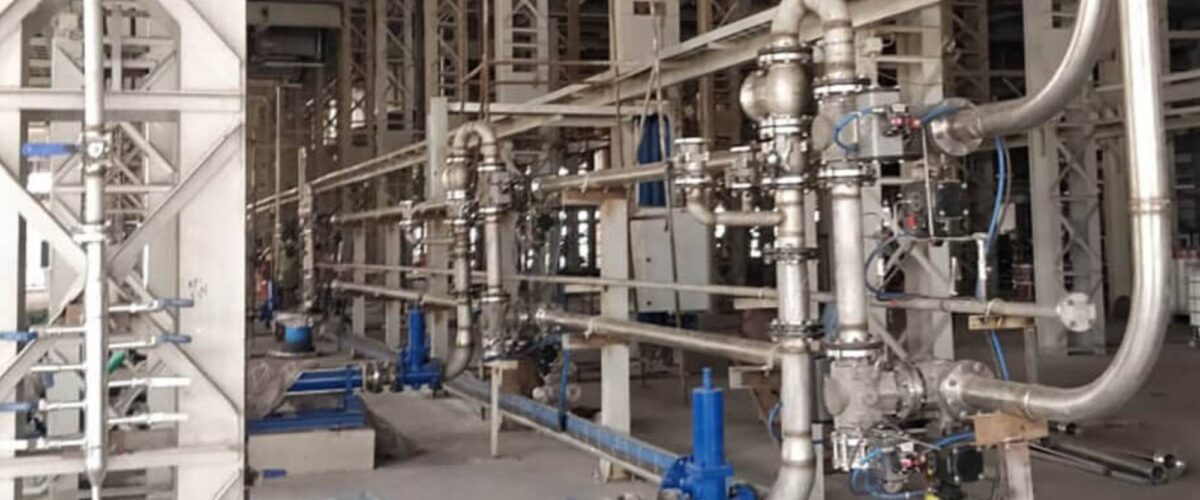The Role of Pigging Systems in Advancing Sustainable Manufacturing
The necessity of addressing environmental impacts and improving resource usage techniques has turned sustainable manufacturing into an urgent goal for enterprises worldwide. A surge of innovative ideas has emerged from the need to tackle climate change and promote ethical behaviour. Among these, pigging systems have garnered attention due to their significant contributions to environmentally friendly production
Originally developed for the oil and gas industry’s pipeline cleaning needs, pigging systems have experienced substantial growth in usage across various sectors. Their adaptability has made them a valuable tool for achieving enhanced efficiency, reduced waste, and overall sustainability.
Pigging systems are primarily being integrated for their ability to maximise process efficiency and minimise environmental impact. These systems excel in pipe cleaning, preventing contamination, and ensuring smooth material flow. Pigging technology offers tangible benefits to enterprises, including increased production yields, reduced downtime, and enhanced product quality.
The capacity of pigging systems to minimise waste is a crucial aspect that contributes to their sustainability. By facilitating the recovery of leftover products in pipelines, these systems reduce material waste, thereby lowering the overall environmental impact of manufacturing operations. This not only enhances the financial sustainability of industrial operations but also aligns with the global shift towards circular economy principles.
Moreover, pigging methods play a vital role in resource conservation. By optimising raw material consumption and reducing waste, these technologies assist enterprises in achieving more sustainable resource utilisation. The positive ripple effects extend to entire supply chains and foster a culture of ethical manufacturing practices that transcends individual businesses.
In conclusion, the evolution of pigging systems from a specialised tool in the oil and gas industry to a versatile solution for various sectors underscores their significance in sustainable manufacturing. Due to their ability to boost productivity, minimise waste, and optimise resource usage, pigging systems are a crucial instrument in the ongoing global movement toward sustainable and environmentally friendly industrial practices.
1. Pigging systems Minimising Product Loss and Waste:
Pigging systems play a crucial role in promoting sustainable production practices by efficiently minimising waste and product loss. This is particularly evident in industries like chemicals, food and beverage, and pharmaceuticals, where even small amounts of leftover materials from production shifts or cleaning procedures can lead to significant financial losses and environmental harm.
These systems rely on specialised equipment known as pigs, which are designed to navigate through the intricate network of pipes to collect and clean leftover materials that would otherwise be discarded. Strategically placed pigs ensure effective pipeline purging, allowing businesses to switch between products or conduct cleaning operations with minimal material wastage.
By reducing product waste in the context of sustainable manufacturing, pigging systems not only benefit the economy but also contribute to environmental preservation efforts. They provide thorough cleaning, minimising the risk of cross-contamination between different products, which is crucial in industries where product quality and purity are paramount. This ensures that the final products meet stringent regulatory standards while safeguarding the integrity of the production process.
2. Pigging systems Water Conservation:
Water scarcity is a growing global concern that demands more attention, prompting industries to adopt measures for sustainable water management. Among these strategies, pigging systems are crucial for water conservation and transforming cleaning procedures. Previously, pipeline cleaning required significant water usage, but pigging methods have shifted this perspective. These systems utilise pigs, tools equipped with brushes or cleaning solutions, to meticulously clear pipes of residue. This targeted approach ensures efficient water usage, aligning with the imperative for sustainable resource management.
Amid mounting concerns about global water scarcity, industries are acknowledging the pressing need to reduce water consumption. Pigging systems provide an environmentally sustainable alternative to traditional cleaning methods, addressing this challenge while also reshaping industry benchmarks. By minimising the requirement for large volumes of water, pigging systems enhance operational efficiency while also safeguarding the environment. Beyond water conservation, these systems enhance cleaning precision, extending the lifespan and functionality of pipelines.
Taken together, pigging systems signify a fundamental shift in industrial processes by harmonising environmental responsibility with operational efficiency. The adoption of pigging systems represents a positive stride towards a future where businesses prioritise water conservation, especially as more industries grapple with the imperative of sustainable practices. These systems embody a deliberate shift in industrial practices, recognizing the paramount importance of preserving water, the most precious resource on our planet.
3. Pigging systems Energy Efficiency:
Pigging systems are crucial for enhancing the energy efficiency of manufacturing operations. They represent a groundbreaking approach to cleaning, unlike traditional methods that often require shutdowns and extended equipment downtime for maintenance. These systems enable effective cleaning tasks to be carried out without the need for complete shutdowns, facilitating a seamless transition to more continuous operations.
Minimising idle time is essential for reducing energy consumption. According to conventional thinking, energy usage increases when equipment is cleaned during shutdowns. Pigging systems disrupt this pattern by allowing producers to conduct cleaning activities concurrently with ongoing operations. This enhances the sustainability of industrial facilities by reducing overall downtime and saving a significant amount of energy.
Pigging activities are continuous, fostering a positive correlation between production and cleanliness. By minimising disruptions and idle periods, this innovative cleaning technique optimises resources and ensures that production processes operate at peak efficiency. Therefore, the integration of pigging systems becomes a fundamental component in the pursuit of enhanced energy efficiency in the manufacturing sector, aligning with current sustainability goals and making a substantial contribution to the industry’s overall environmentally conscious efforts.

4. Reducing Emissions and Carbon Footprint:
Pigging systems play a crucial role in reducing emissions and the carbon footprint of industrial activities by enabling cleaner, more efficient production processes. Integrating pigging systems is a strategic and necessary decision in today’s world, where enterprises must comply with strict environmental regulations and strive to achieve ambitious sustainability goals. These technologies optimise energy use, reduce water usage, and significantly minimise waste production. These efficiencies have a ripple effect, leading to a substantial reduction in greenhouse gas emissions and promoting a more sustainable and environmentally conscious manufacturing ecosystem.
Beyond meeting environmental regulations, pigging systems offer several advantages. Their implementation demonstrates a proactive commitment to environmentally friendly practices, aligning companies with the global movement toward a more sustainable future. Pigging systems are notable for their ability to streamline production processes, enhancing operational efficiency and promoting resource conservation. Given their combined effects on operational efficiency and environmental sustainability, pigging systems are indispensable tools for companies navigating the complex landscape of twenty-first-century manufacturing. They serve as a shining example of innovation as enterprises strive to balance ecological responsibility with commercial success, providing a practical and efficient way to align industrial operations with environmental stewardship requirements.
5. Improved Product Quality and Consistency:
Pigging systems play a crucial role in promoting sustainability by maximising resources and enhancing product quality. These technologies actively contribute to preserving the integrity of each manufacturing batch, surpassing simple resource efficiency. Pigging systems ensure that quality requirements are met by thoroughly cleaning the pipeline and preventing cross-contamination during production transitions. This systematic approach has a significant impact, consistently delivering high-quality products.
The dual benefits of resource efficiency and quality assurance underscore the importance of pigging systems in today’s sustainable manufacturing environment. They are a key element in achieving both economic and ecological goals as industries prioritize ethical production methods. Their ability to balance environmental awareness with efficiency positions them at the forefront of efforts to create a more sustainable and ethical industrial future.
6. Life Cycle Assessment and Long-Term Sustainability:
To fully appreciate the many sustainable benefits of pigging systems, it is essential to conduct a comprehensive life cycle assessment (LCA). LCAs are crucial for closely examining the environmental effects of a system or product, tracking it from raw material extraction to final disposal at the end of its useful life. LCAs consistently reveal a positive and significant overall impact of pigging systems, highlighting their long-term sustainability.
These assessments frequently underscore the importance of reducing waste production to support sustainability. Pigging systems are designed to maximise product transfer efficiency and minimise leftover products in pipelines, leading to environmentally friendly practices and financial gains through waste reduction.
Moreover, the intrinsic energy efficiency of pigging systems significantly contributes to their environmentally friendly impact. The environmental responsibility of pigging systems is further supported by the observable energy savings resulting from optimising product transportation operations throughout their life cycle.
Conclusion:
In conclusion, the advancement of sustainable manufacturing techniques is greatly enhanced by pigging systems. These technologies go beyond just reducing waste and product loss, offering a more comprehensive approach. Pigging systems demonstrate their creativity as solutions aligned with the global trend toward environmentally responsible industrial operations. They actively conserve water, improve energy efficiency, and eliminate pollutants. The adoption of pigging systems becomes a strategic and forward-looking investment as industries increasingly embrace sustainability. These technologies not only increase efficiency but also showcase a company’s commitment to environmental responsibility.
Pigging systems offer a revolutionary opportunity for businesses seeking to align with global sustainability goals through reduced resource usage and environmental impact. In simple terms, using pigging systems is a proactive step toward a more environmentally friendly production environment. This paradigm shift toward efficient and ethical manufacturing methods not only benefits companies but also contributes to the larger effort of creating an ecologically friendly and sustainable industrial ecosystem worldwide.

